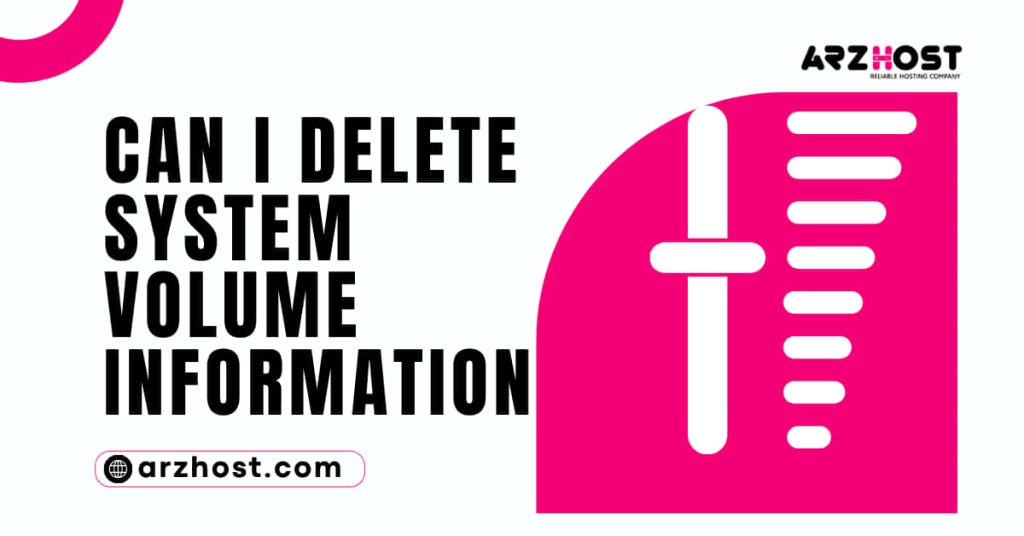Here at Arzhost, we discuss the tutorial Can I Delete System Volume Information? In reality, because the data, it contains for system recovery and data from specific service applications. It is preferable to avoid manually deleting files in System Volume Information folder. You can essentially get rid of System Volume Information by disabling a few important values from system restore point and/or the history of files in the System Volume Information directory.
Particularly if the folders are on a system disc and the files are indexed by Windows Search. A business shouldn’t delete a location that contains data and metadata linked to Backup, Volume Shadow Copy, and Search indexer.
Information about system Volume, is it a virus?
Can I Delete System Volume Information? Every drive or partition has a hidden and secure folder called the System Volume Information folder. If you have previously linked your SD card, USB pen drive, and external hard drive to your Windows computer. It is even present on those devices. There is no malware or virus in it.
System Volume Information Folder: Where is it? A protected Windows operating folder is System Volume Information folder. You must force Windows display hidden and protected files and folders to see it. Then, you will notice it at drive’s root.
What does my phone’s system volume mean?
The volume type Agora RTC SDK utilizes to manage volume is system volume. Which is a volume that has been modified on the device. For instance, if SDK makes use of in-call volume, changing system volume also affects in-call volume.
Can I Delete System Volume Information? The Recycle Bin stores files and folders that you (and other users on PC) delete in a secret and secured folder on each drive called $Recycle. bin. If you are logged in as an administrator, you can delete it, but Windows will regenerate it once you delete more files from same disc.
How do I get rid of the GUID computer virus?
Can I Delete System Volume Information? If your computer has a virus, these ten easy procedures will assist you in getting rid of it:
- Download and set up a virus scanner as the first step.
- Cut off internet access.
- Restarting your computer in safe mode is step three.
- Delete any temporary files in step four.
- Perform a virus scan.
- Delete or quarantine the infection in step six.
How can system volume information be changed? Activate Computer Management. Right-click Shared Folders in a terminal tree, choose All Tasks and then choose Configure Shadow Copies. Pick Settings, then click volume where you wish to make modifications (in our example, C:).
Do you require details about the system volume?
Delete the System Volume Information folder, please. As was discussed before, System Volume Information folder houses crucial operating system data. Therefore, leave it as is. Reduce the system restore folder if its large size is an issue for you.
Can I Delete System Volume Information? The Windows installer cache is located in C: Windows Installer folder, which should not be destroyed. It is used to store crucial files for programs installed using Windows Installer technology. The apps and patches that have been installed on computer are updated and maintained using the installer cache.
How do I remove files from my hard disc forever?
In the File Explorer Ribbon at top of the window, pick Delete, or choose Permanently delete by clicking arrow next to Delete. The file is deleted permanently when you choose option to permanently delete it rather than sending it to Recycle Bin when you click Delete.
McAfee: Is It a Virus? Yes. McAfee is a reliable antivirus programme that is priceless. Your computer will be protected from viruses and other online threats thanks to its comprehensive security suite. On Windows, Android, Mac, and iOS, it performs admirably, and McAfee LiveSafe package is compatible with an unlimited number of personal devices.
How can I tell if a virus is on my laptop?
Can I Delete System Volume Information? Your computer may be infected with a virus if you detect any of the following problems with it:
- Performing poorly on computer (taking a long time to start up or open programs)
- Difficulties with resuming or shutting down.
- Missing documents
- System errors or crashes on a regular basis.
- Sudden pop-up windows
How can I locate a virus that is concealed on my computer? To open Windows Security, go to Settings > Update & Security > Windows Security. “Virus & threat protection” can be clicked to run an anti-malware scan. To run a malware, check on your PC, click “Quick Scan.” Windows Security will run a scan and provide its findings. How can I tell if a virus is on my laptop?
What is the best way to move files from system volume information?
Can I Delete System Volume Information? Disabling shadow copies and/or setting a low use limit (for instance, 100 MB) can cause System Volume Information folder to be immediately cleaned away when you relocate it. The drive letter that it is stored on can then be changed.
How can I take control of volume information folder on my system? Step Two: Modify Permission:
- Launch the File Explorer tab.
- Afterwards, navigate to C:/System Volume Information.
- To begin, select the “Security” option.
- Then select “Advanced.”
- Select “Change” next to “Owner”: when the Advanced Security options display.
- Afterward, select “Advanced”
Can I get rid of Windows XP?
Your prior version of Windows will be automatically erased from your computer ten days after you update to Windows 10. You can securely delete it yourself if you need free up disc space and are certain that your files and settings are where you want them to be on Windows 10.
How are System Restore points deleted? In Windows 7, 8, 10, and 11, remove a restore point. In Windows 11, select the magnifying glass icon on the taskbar. Type “restore point” and hit the Enter key in text area at top of search window. Delete a restore point can be done in Windows 7, 8, and 10 by pressing the Windows key and entering command.
Old MSP files can I delete?
Can I Delete System Volume Information? MSP used for apps you have installed right now. If you wish to update, change, or uninstall an application from your computer. You must have these files. Don’t just randomly erase them. You can find yourself uncontrolled on occasion.
How can I wipe up the installer folder? Run Disk Cleanup by choosing “Free up disc space by eliminating unwanted files” from the menu that appears after typing “clean” into the Windows start screen. Choose the drive that needs cleaning. Then select “Clean up system files” (and enter identifications if required).
Can I get rid of the installer? A. You can delete the outdated installation programs that have accumulated in the Downloads folder if you have already installed apps on your computer. Unless you need to reinstall the program you downloaded, installation files basically idle after being run.















